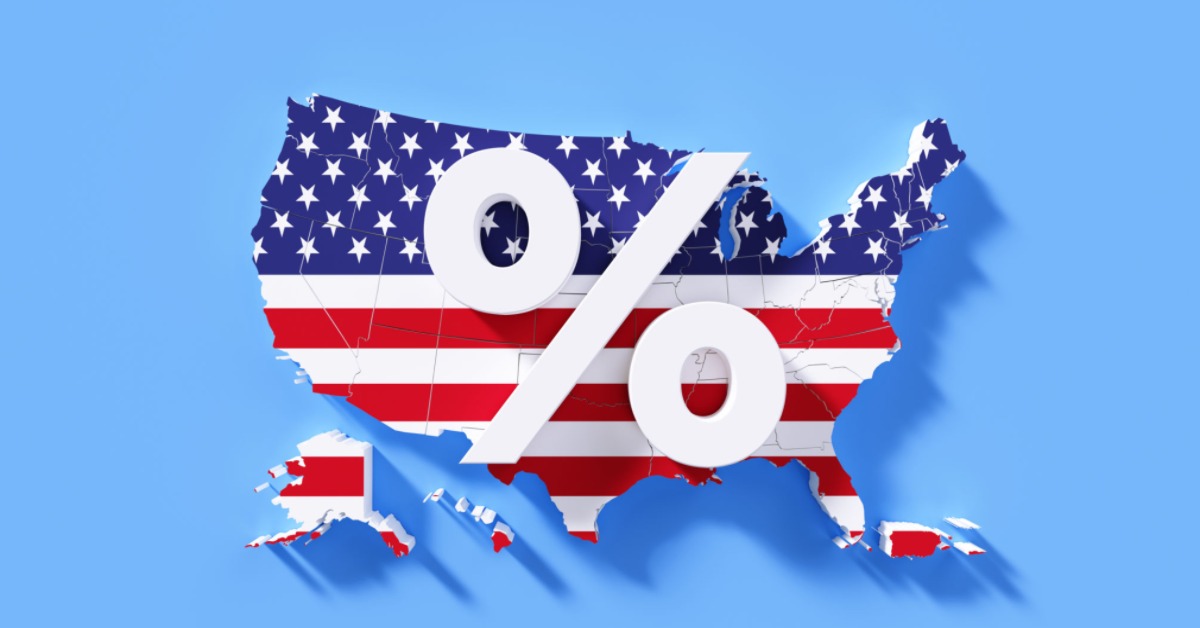Looking for the best mortgage rates today, July 11, 2025? You're in the right place. Currently, the states boasting the lowest 30-year new purchase mortgage rates are New York, California, Virginia, Washington, Colorado, Massachusetts, and Pennsylvania, with averages ranging from 6.57% to 6.78%. Let's explore the factors that influence these rates and how you can secure the most favorable mortgage deal.
Mortgage Rates Today: The States Offering Lowest Rates
Understanding Today's Mortgage Rate Picture (July 11, 2025)
While national averages provide a general overview, mortgage rates can vary significantly from state to state. Why? Because different lenders operate in different regions. Each lender has varying risk management strategies. State-level regulations, credit scores, and average loan sizes also play roles.
According to Investopedia's report and Zillow's data, here's a quick snapshot of where rates stand today:
- National Average (30-Year Fixed): 6.83%
- The states with the cheapest 30-year new purchase mortgage rates: New York, California, Virginia, Washington, Colorado, Massachusetts, and Pennsylvania with rates between 6.57% and 6.78%
- States with Highest Rates: Alaska, Alabama, South Dakota, Kansas, West Virginia, Wyoming, Oklahoma, and Iowa ranging from 6.89% to 6.96%
- Compared to Mid-May 2025: Rates are down from a high of 7.15%
- Compared to March 2025: Rates are higher than the 6.50% low
- Compared to September 2024: Rates are higher than the two-year low of 5.89%
National Averages of Lenders' Best Mortgage Rates
| Loan Type | New Purchase |
|---|---|
| 30-Year Fixed | 6.83% |
| FHA 30-Year Fixed | 7.55% |
| 15-Year Fixed | 5.84% |
| Jumbo 30-Year Fixed | 6.80% |
| 5/6 ARM | 7.48% |
These are national averages. They serve as a good starting point. However, it's vital to remember that these are averages, and your individual rate will differ.
Why the Rate Discrepancy Between States?
As I mentioned, various factors cause mortgage rates to fluctuate across states. Let's break them down:
- Lender Presence: Not all lenders operate in every state. Limited competition can lead to higher rates.
- State Regulations: Each state has different laws governing mortgages. Some states may have regulations that increase lender costs.
- Credit Score Averages: States with lower average credit scores might see slightly higher rates. Lenders perceive lending in such regions as riskier. Credit scores directly impact the mortgage rates.
- Average Loan Size: Loan size correlates with rates. This is because operational costs are the same, regardless of the size of the loan.
- Risk Management: Lenders' assessment of risk is subjective. It depends on their appetite for risk.
States with the Lowest Mortgage Rates: What's Their Secret?
So, what makes New York, California, Virginia, Washington, Colorado, Massachusetts and Pennsylvania so attractive in terms of rates? It's usually a combination of several factors:
- Strong Competition: These states often have many active lenders competing for business.
- Higher Credit Scores: Generally, these states have residents with higher average credit scores.
- Stable Housing Markets: Perceived stability in the housing market makes lenders feel more secure.
- Favorable Regulations: Some may have regulations that streamline the mortgage process, reducing costs for lenders.
A Closer Look
Let's consider California. It has a huge real estate market and stiff competition among mortgage lenders. This competition helps drive rates down. Also, California's economy is strong and dynamic. That helps reassure lenders.
Don't Get Fooled: Understanding Advertised Rates
You've probably seen super-low mortgage rates advertised online. These teaser rates can be tempting. But here’s what I've learned over the years: they're not always what they seem.
- Points: Many advertised rates require you to pay points upfront. Each point equals 1% of the loan amount.
- Credit Score: These rates usually assume you have a near-perfect credit score. This is something that not many people possess
- Loan Size: Some advertised rates are only available for smaller loan amounts.
- Hypothetical Borrower: The advertised low rates are usually aimed at attracting a hypothetical borrower. This borrower is least likely to default on the loan.
The Rates You See Here Are Averages
It's important to emphasize that the rates I'm discussing in this article are averages. The rate you actually get depends on your specific circumstances. This includes credit score, income, debt-to-income ratio, down payment, and the type of loan you choose.
National Mortgage Rate Trends: What's Influencing the Market?
Mortgage rates don't exist in a vacuum. They're influenced by a myriad of factors, including:
- Bond Market: Mortgage rates closely track the 10-year Treasury yield.
- Federal Reserve (The Fed): The Fed's monetary policy significantly impacts rates. The central bank manages monetary policy by setting the federal funds rate.
- Inflation: Rising inflation pushes rates higher.
- Economic Growth: A strong economy may lead to higher rates.
- Competition Among Lenders: More competition can lead to lower rates, as lenders vie for your business.
Recent Fed Actions: A Deeper Dive
The Fed has been a key player in shaping mortgage rates. Here's a quick recap of recent actions and their potential impact:
- Rate Cuts in Late 2024: Three rate cuts lowered the federal funds rate. This had a soothing effect in the market.
- 2025 Outlook: The Fed plans two more rate cuts in 2025. But, when exactly they'll happen is still under debate. There are many variables and uncertainty involved in the whole process. The first cut may be in September 2025.
- Tariffs and Inflation: Tariffs could lead to higher inflation. This might impact the timing of rate cuts.
- Economic Slowdown: A slowing economy could prompt the Fed to cut rates sooner rather than later.
- Political Pressure: Political pressure doesn't directly influence the Fed. Although the central bank maintains its independence when making decisions.
Read More:
States With the Lowest Mortgage Rates on July 10, 2025
Are Mortgage Rates Expected to Go Down Soon: A Realistic Outlook
Key Influences on Fed Policy
| Factor | Impact |
|---|---|
| Tariffs | Could cause inflation and delay rate cuts |
| Economic Slowdown | Could prompt earlier rate cuts |
| Political Pressure | Minimal direct influence, Fed emphasizes data dependence |
What About the Future?
Projections suggest that rates may gradually decline in the coming years. This is based on the assumption that the Fed will continue its easing cycle. However, remember that these are just projections. Unexpected events can throw things off course.
Taking Advantage of Lower Rates: Refinancing Your Mortgage
If you already own a home, refinancing your mortgage could save you money. Refinancing involves replacing your existing mortgage with a new one, ideally at a lower interest rate.
When lower rates become available, it's something you should think about. Evaluate your options. Do the Math.
Check to see if the overall savings outweigh the costs.
Tips for Securing the Best Mortgage Rate
Securing the best rate requires some effort. So, here's my advice:
- Improve Your Credit Score: This is the most important factor. Pay your bills. Pay on time.
- Save for a Larger Down Payment: This reduces the risk for the lender.
- Shop Around: Get quotes from multiple lenders.
- Consider Different Loan Types: Explore fixed-rate, adjustable-rate, and FHA loans.
- Negotiate: Don’t be afraid to negotiate with lenders.
- Get Pre-Approved: This shows sellers that you’re a serious buyer.
The Impact of Down Payments
| Down Payment | Impact on Interest Rate |
|---|---|
| 5% | Higher risk, higher rate |
| 20% | Lower risk, potentially lower rate |
Your financial health is worth investing in. Taking steps for credit and savings is worth considering. This will go a long way in helping you secure competitive mortgage rates.
Final Thoughts
Mortgage rates are constantly changing. Keep an eye on the market and be prepared to act when the time is right. Don’t be afraid to seek help. Work with a qualified mortgage broker or financial advisor. They can help navigate the complexities of the mortgage market.
Keep gathering information. Stay informed. And remember, finding the right mortgage is possible with the right approach.
Invest in Real Estate in the Top U.S. Markets
Investing in turnkey real estate can help you secure consistent returns with fluctuating mortgage rates.
Expand your portfolio confidently, even in a shifting interest rate environment.
Speak with our expert investment counselors (No Obligation):
(800) 611-3060
Also Read:
- Will Mortgage Rates Go Down in 2025: Morgan Stanley's Forecast
- Expect High Mortgage Rates Until 2026: Fannie Mae's 2-Year Forecast
- Mortgage Rate Predictions 2025 from 4 Leading Housing Experts
- Mortgage Rates Forecast for the Next 3 Years: 2025 to 2027
- 30-Year Mortgage Rate Forecast for the Next 5 Years
- 15-Year Mortgage Rate Forecast for the Next 5 Years
- Why Are Mortgage Rates Going Up in 2025: Will Rates Drop?
- Why Are Mortgage Rates So High and Predictions for 2025
- Will Mortgage Rates Ever Be 3% Again in the Future?
- Mortgage Rates Predictions for Next 2 Years
- Mortgage Rate Predictions for Next 5 Years
- Mortgage Rate Predictions: Why 2% and 3% Rates are Out of Reach
- How Lower Mortgage Rates Can Save You Thousands?
- How to Get a Low Mortgage Interest Rate?
- Will Mortgage Rates Ever Be 4% Again?



